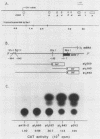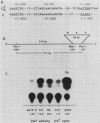Abstract
The invariant chain (Ii) is a glycoprotein coexpressed with the major histocompatibility complex (MHC) class II antigens. Although Ii is encoded by a single gene unlinked to the MHC gene complex, Ii and MHC class II appear to have similar patterns of tissue specific expression and generally are coordinately regulated by cytokines. Here we present evidence that transcription of the murine Ii gene is controlled by multiple cis-acting elements. The 5' regulatory region of the Ii gene appears to be combined of conserved class II regulatory elements with promoter elements commonly found in other eucaryotic genes. A region containing characteristic class II promoter elements (H box, X box, and a modified Y box) serves as an upstream enhancer in the Ii gene and might contribute to the coexpression of MHC class II and Ii genes. A series of positive control elements, the kappa B element, Sp1-binding site, and CCAAT box, are present in the Ii promoter and apparently serve distinct regulatory functions. The kappa B site in the Ii gene is a cell type-specific element, contributing to expression in a B-cell line but not in a fibroblast cell line, and the Sp1 site is required by the H-X-Y' enhancer element to stimulate promoter activity. In addition, an Ii enhancer in the first intron that specifically stimulates its own promoter has been identified. Our results suggest that a sequence match between enhancers and certain promoter elements is critical.
Full text
PDF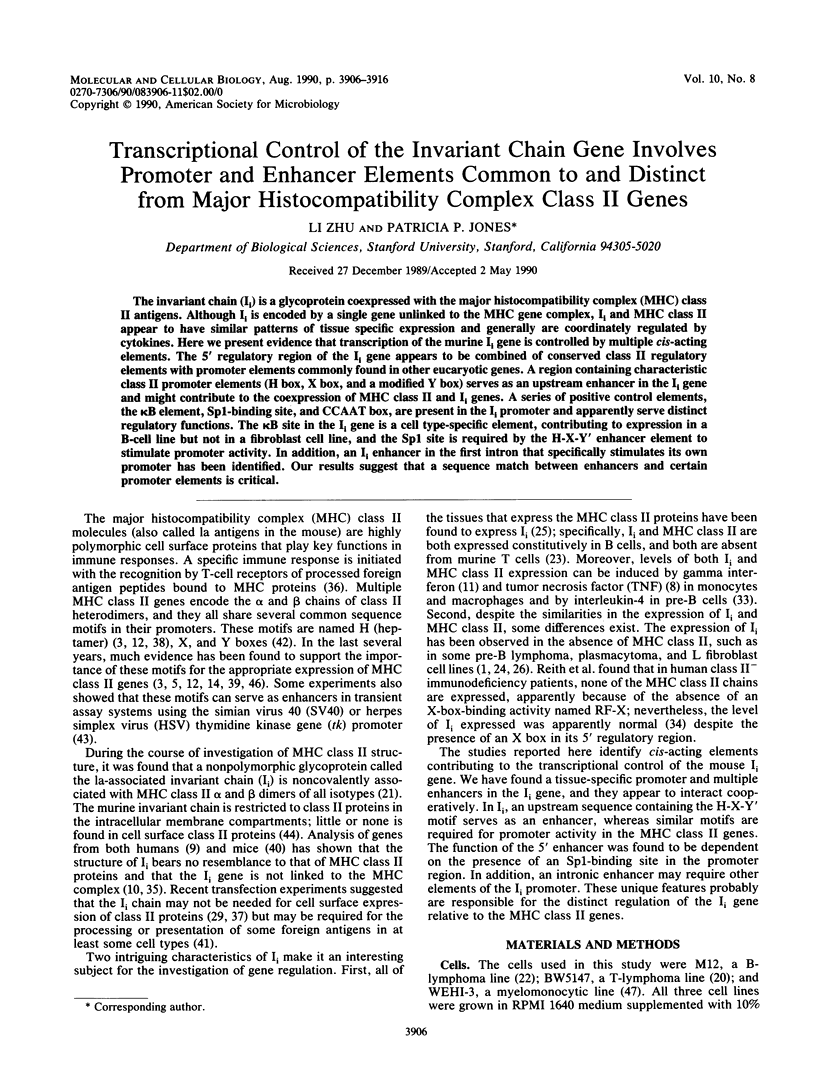
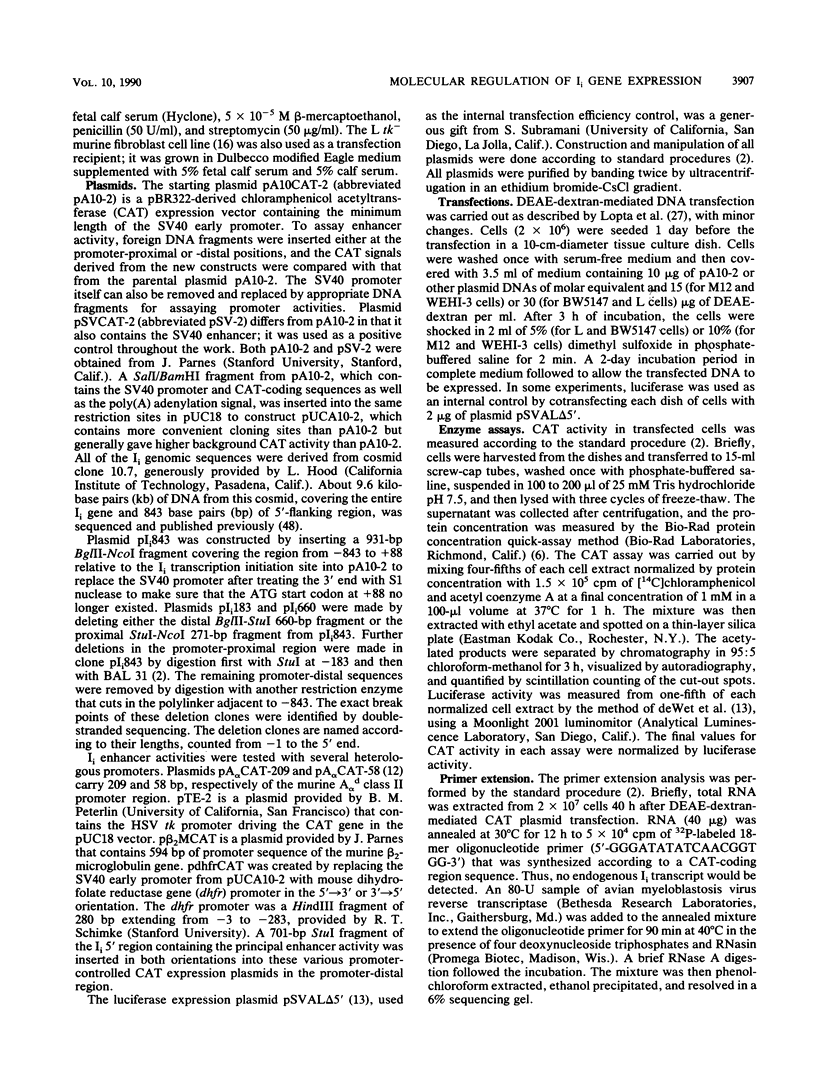
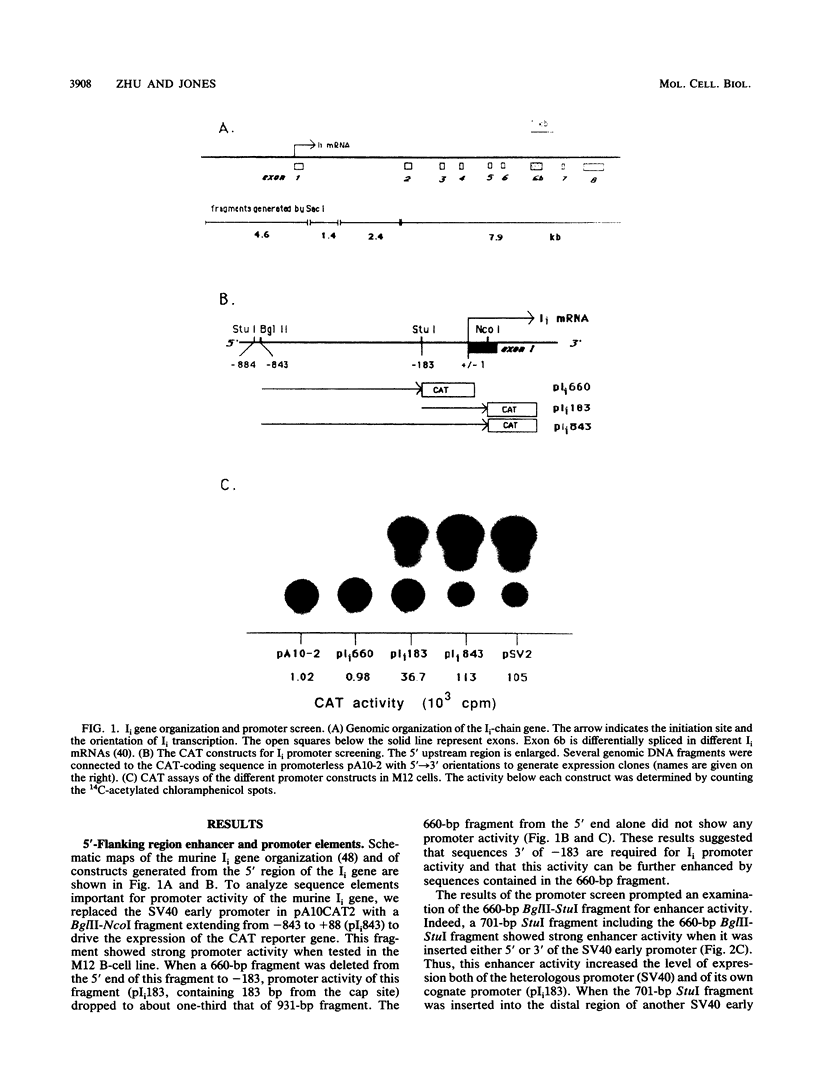
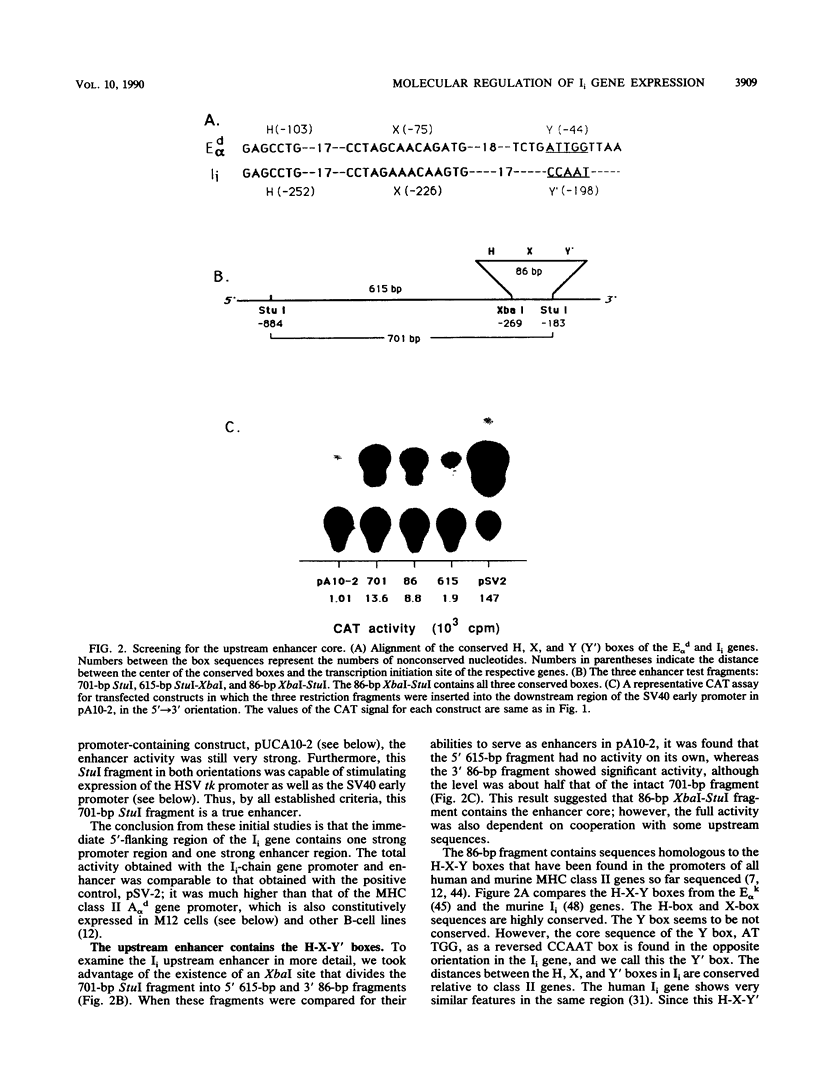
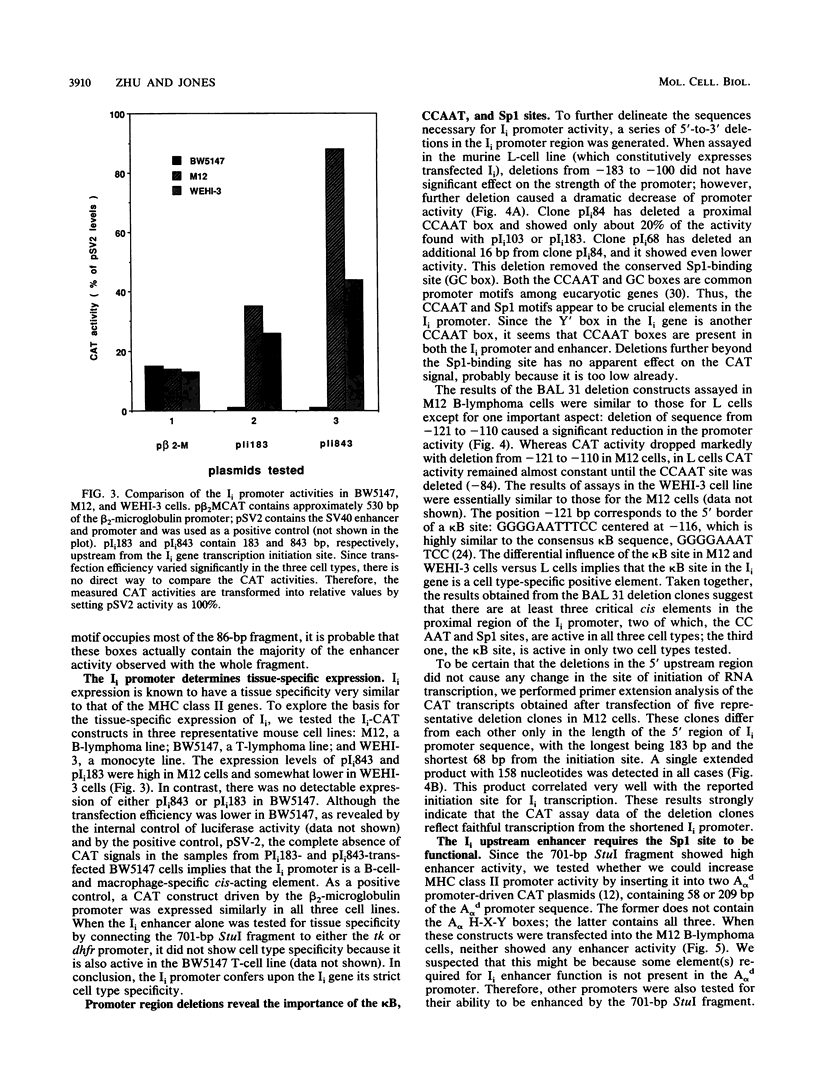
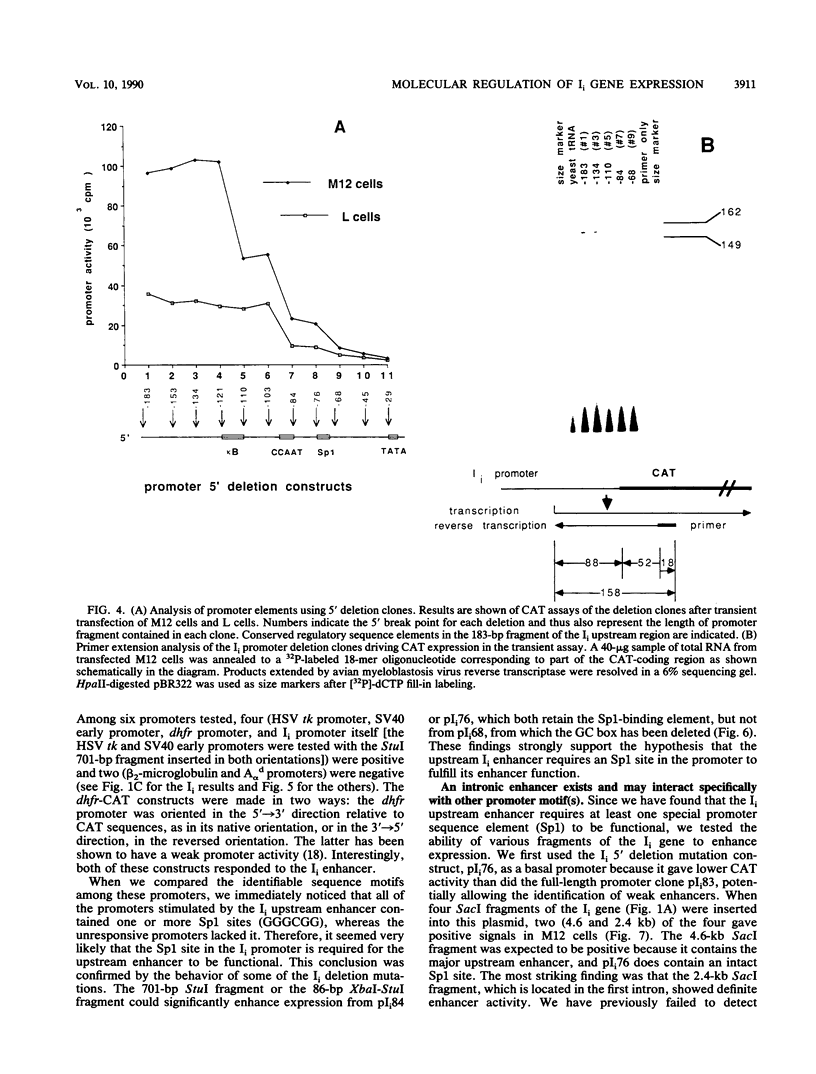
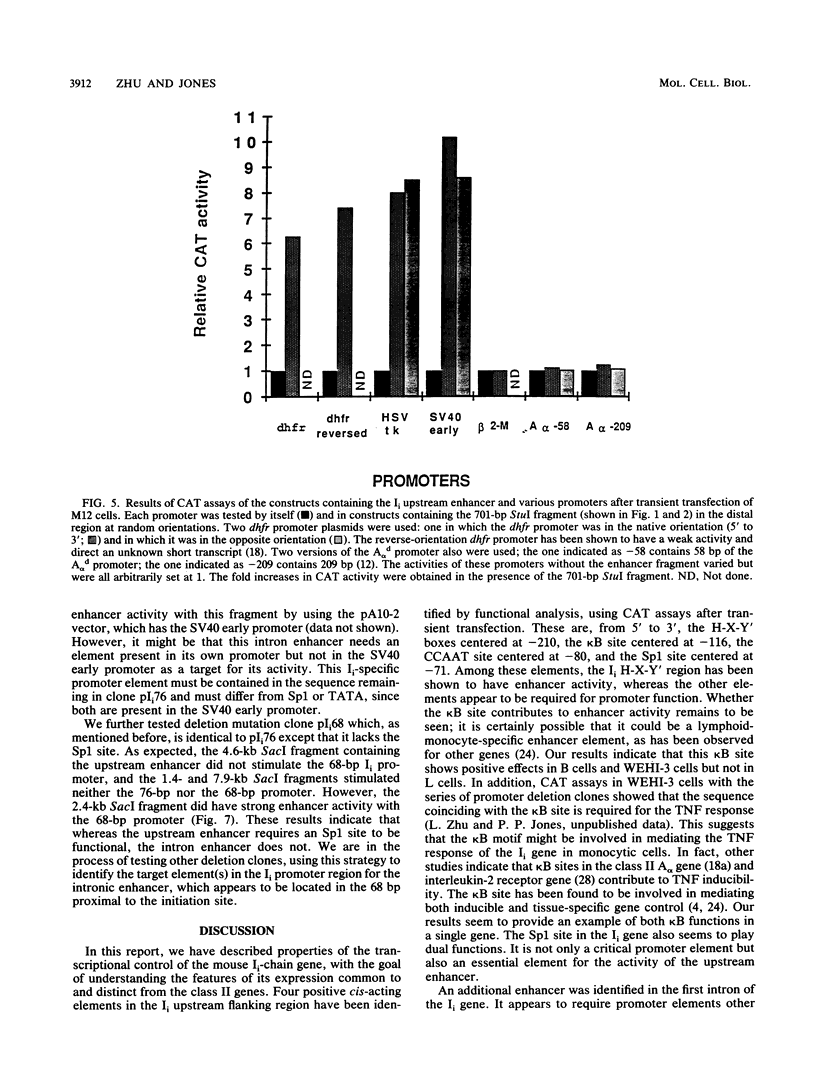
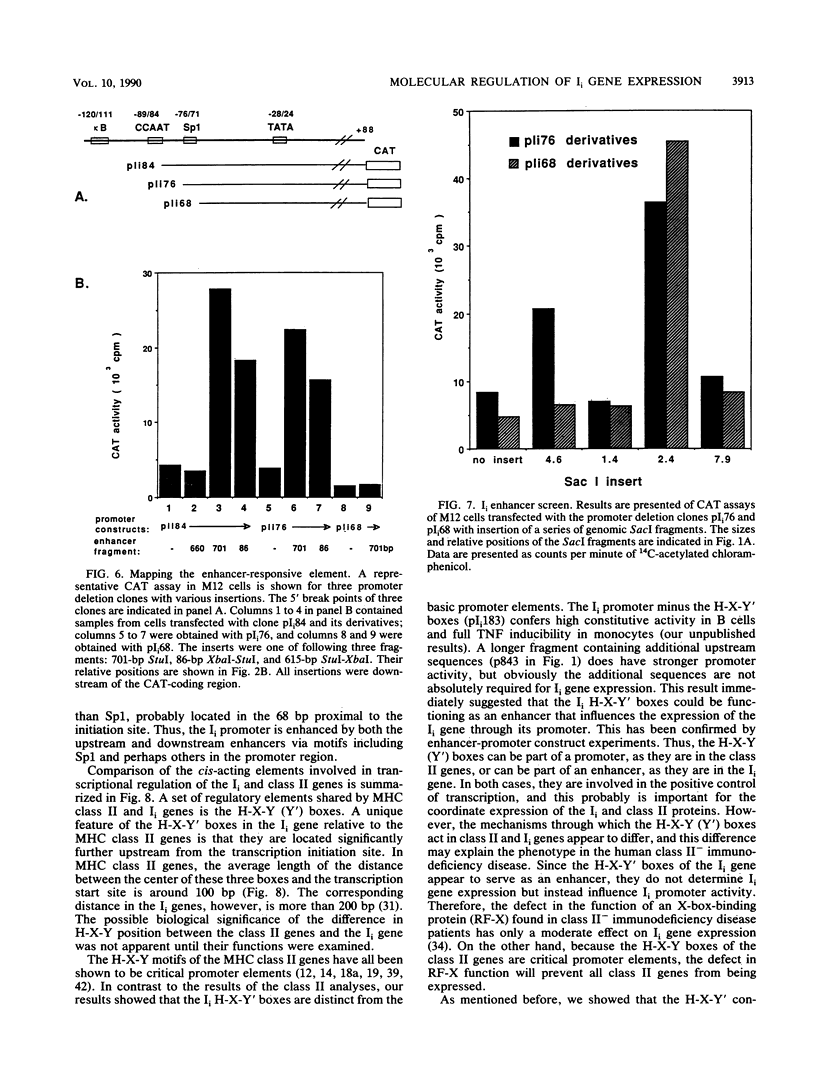
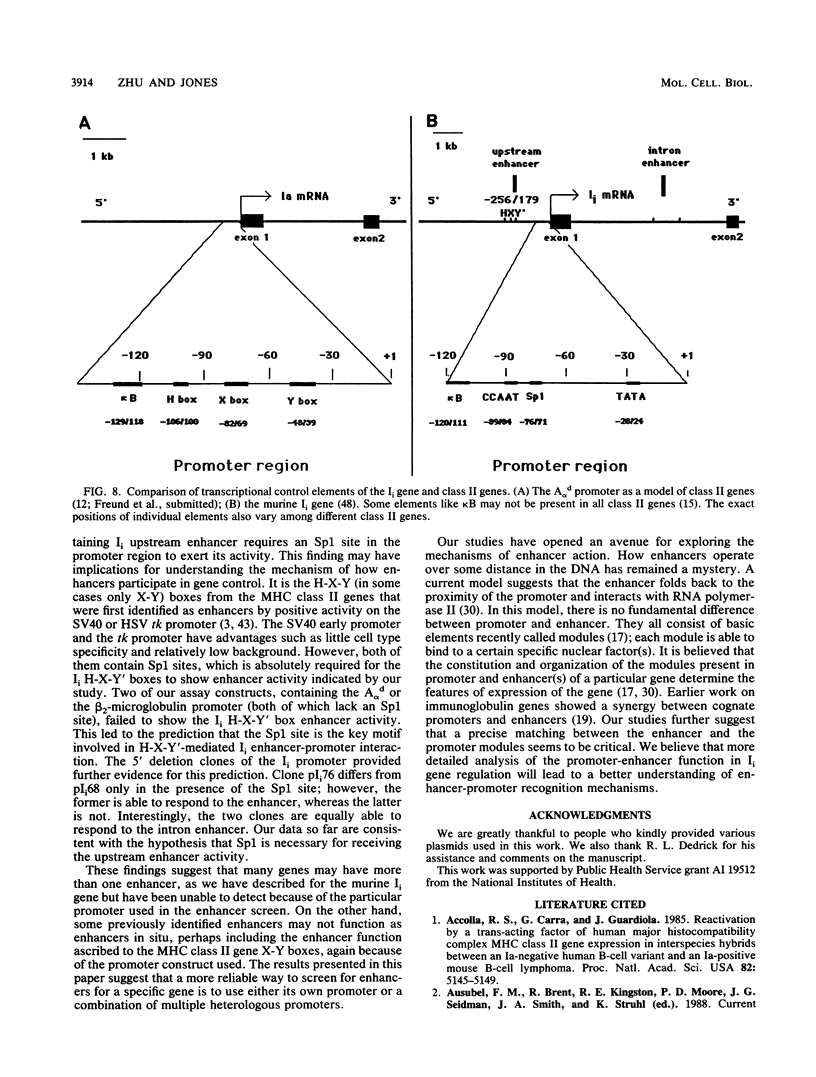
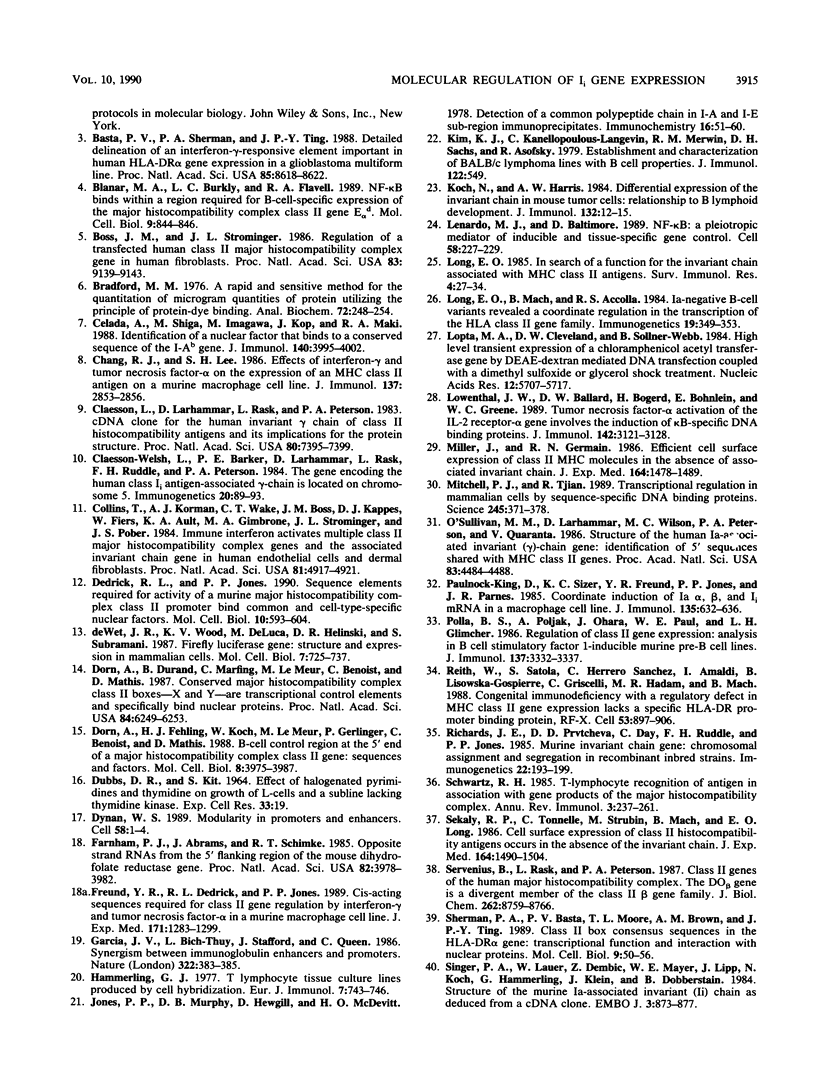
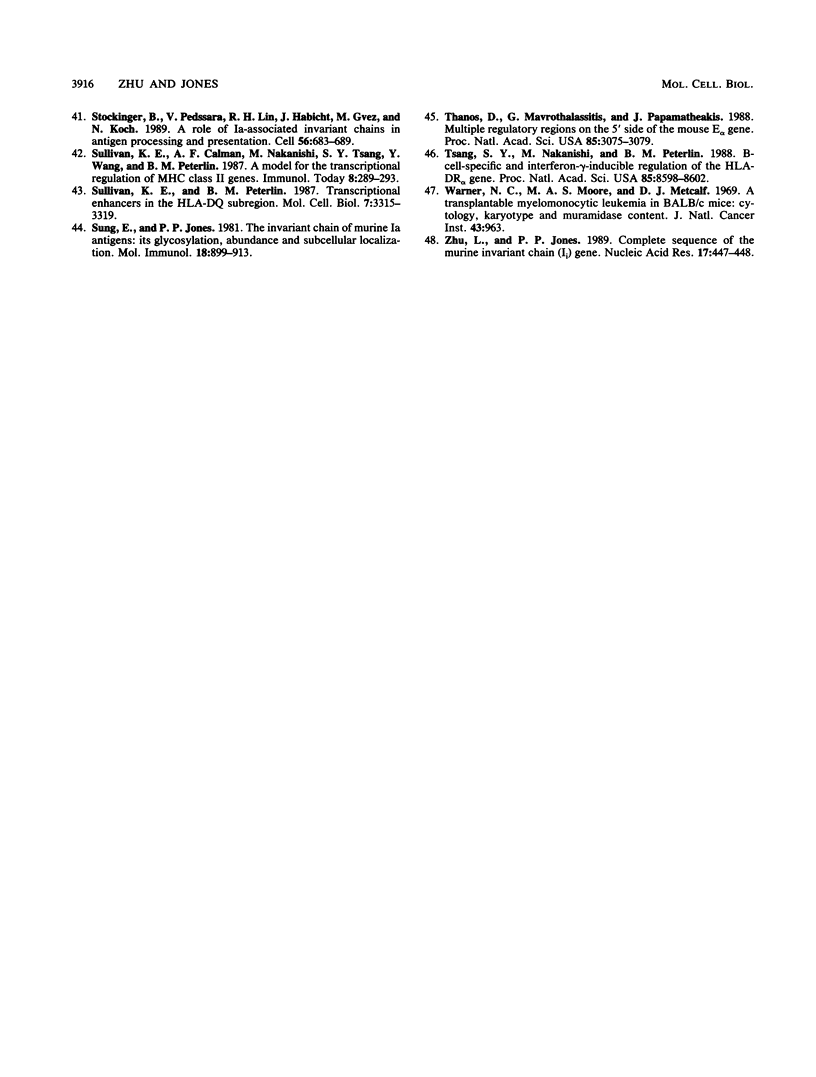
Images in this article
Selected References
These references are in PubMed. This may not be the complete list of references from this article.
- Accolla R. S., Carra G., Guardiola J. Reactivation by a trans-acting factor of human major histocompatibility complex Ia gene expression in interspecies hybrids between an Ia-negative human B-cell variant and an Ia-positive mouse B-cell lymphoma. Proc Natl Acad Sci U S A. 1985 Aug;82(15):5145–5149. doi: 10.1073/pnas.82.15.5145. [DOI] [PMC free article] [PubMed] [Google Scholar]
- Basta P. V., Sherman P. A., Ting J. P. Detailed delineation of an interferon-gamma-responsive element important in human HLA-DRA gene expression in a glioblastoma multiform line. Proc Natl Acad Sci U S A. 1988 Nov;85(22):8618–8622. doi: 10.1073/pnas.85.22.8618. [DOI] [PMC free article] [PubMed] [Google Scholar]
- Blanar M. A., Burkly L. C., Flavell R. A. NF-kappa B binds within a region required for B-cell-specific expression of major histocompatibility complex class II gene E alpha d. Mol Cell Biol. 1989 Feb;9(2):844–846. doi: 10.1128/mcb.9.2.844. [DOI] [PMC free article] [PubMed] [Google Scholar]
- Boss J. M., Strominger J. L. Regulation of a transfected human class II major histocompatibility complex gene in human fibroblasts. Proc Natl Acad Sci U S A. 1986 Dec;83(23):9139–9143. doi: 10.1073/pnas.83.23.9139. [DOI] [PMC free article] [PubMed] [Google Scholar]
- Bradford M. M. A rapid and sensitive method for the quantitation of microgram quantities of protein utilizing the principle of protein-dye binding. Anal Biochem. 1976 May 7;72:248–254. doi: 10.1006/abio.1976.9999. [DOI] [PubMed] [Google Scholar]
- Celada A., Shiga M., Imagawa M., Kop J., Maki R. A. Identification of a nuclear factor that binds to a conserved sequence of the I-A beta gene. J Immunol. 1988 Jun 1;140(11):3995–4002. [PubMed] [Google Scholar]
- Chang R. J., Lee S. H. Effects of interferon-gamma and tumor necrosis factor-alpha on the expression of an Ia antigen on a murine macrophage cell line. J Immunol. 1986 Nov 1;137(9):2853–2856. [PubMed] [Google Scholar]
- Claesson-Welsh L., Barker P. E., Larhammar D., Rask L., Ruddle F. H., Peterson P. A. The gene encoding the human class II antigen-associated gamma chain is located on chromosome 5. Immunogenetics. 1984;20(1):89–93. doi: 10.1007/BF00373450. [DOI] [PubMed] [Google Scholar]
- Claesson L., Larhammar D., Rask L., Peterson P. A. cDNA clone for the human invariant gamma chain of class II histocompatibility antigens and its implications for the protein structure. Proc Natl Acad Sci U S A. 1983 Dec;80(24):7395–7399. doi: 10.1073/pnas.80.24.7395. [DOI] [PMC free article] [PubMed] [Google Scholar]
- Collins T., Korman A. J., Wake C. T., Boss J. M., Kappes D. J., Fiers W., Ault K. A., Gimbrone M. A., Jr, Strominger J. L., Pober J. S. Immune interferon activates multiple class II major histocompatibility complex genes and the associated invariant chain gene in human endothelial cells and dermal fibroblasts. Proc Natl Acad Sci U S A. 1984 Aug;81(15):4917–4921. doi: 10.1073/pnas.81.15.4917. [DOI] [PMC free article] [PubMed] [Google Scholar]
- DUBBS D. R., KIT S. EFFECT OF HALOGENATED PYRIMIDINES AND THYMIDINE ON GROWTH OF L-CELLS AND A SUBLINE LACKING THYMIDINE KINASE. Exp Cell Res. 1964 Jan;33:19–28. doi: 10.1016/s0014-4827(64)81006-5. [DOI] [PubMed] [Google Scholar]
- Dedrick R. L., Jones P. P. Sequence elements required for activity of a murine major histocompatibility complex class II promoter bind common and cell-type-specific nuclear factors. Mol Cell Biol. 1990 Feb;10(2):593–604. doi: 10.1128/mcb.10.2.593. [DOI] [PMC free article] [PubMed] [Google Scholar]
- Dorn A., Durand B., Marfing C., Le Meur M., Benoist C., Mathis D. Conserved major histocompatibility complex class II boxes--X and Y--are transcriptional control elements and specifically bind nuclear proteins. Proc Natl Acad Sci U S A. 1987 Sep;84(17):6249–6253. doi: 10.1073/pnas.84.17.6249. [DOI] [PMC free article] [PubMed] [Google Scholar]
- Dorn A., Fehling H. J., Koch W., Le Meur M., Gerlinger P., Benoist C., Mathis D. B-cell control region at the 5' end of a major histocompatibility complex class II gene: sequences and factors. Mol Cell Biol. 1988 Oct;8(10):3975–3987. doi: 10.1128/mcb.8.10.3975. [DOI] [PMC free article] [PubMed] [Google Scholar]
- Dynan W. S. Modularity in promoters and enhancers. Cell. 1989 Jul 14;58(1):1–4. doi: 10.1016/0092-8674(89)90393-0. [DOI] [PubMed] [Google Scholar]
- Farnham P. J., Abrams J. M., Schimke R. T. Opposite-strand RNAs from the 5' flanking region of the mouse dihydrofolate reductase gene. Proc Natl Acad Sci U S A. 1985 Jun;82(12):3978–3982. doi: 10.1073/pnas.82.12.3978. [DOI] [PMC free article] [PubMed] [Google Scholar]
- Freund Y. R., Dedrick R. L., Jones P. P. cis-acting sequences required for class II gene regulation by interferon gamma and tumor necrosis factor alpha in a murine macrophage cell line. J Exp Med. 1990 Apr 1;171(4):1283–1299. doi: 10.1084/jem.171.4.1283. [DOI] [PMC free article] [PubMed] [Google Scholar]
- Garcia J. V., Bich-Thuy L. T., Stafford J., Queen C. Synergism between immunoglobulin enhancers and promoters. Nature. 1986 Jul 24;322(6077):383–385. doi: 10.1038/322383a0. [DOI] [PubMed] [Google Scholar]
- Hämmerling G. J. T lymphocyte tissue culture lines produced by cell hybridization. Eur J Immunol. 1977 Oct;7(10):743–746. doi: 10.1002/eji.1830071018. [DOI] [PubMed] [Google Scholar]
- Jones P. P., Murphy D. B., Hewgill D., McDevitt H. O. Detection of a common polypeptide chain in I--A and I--E sub-region immunoprecipitates. Mol Immunol. 1979 Jan;16(1):51–60. doi: 10.1016/0161-5890(79)90027-0. [DOI] [PubMed] [Google Scholar]
- Kim K. J., Kanellopoulos-Langevin C., Merwin R. M., Sachs D. H., Asofsky R. Establishment and characterization of BALB/c lymphoma lines with B cell properties. J Immunol. 1979 Feb;122(2):549–554. [PubMed] [Google Scholar]
- Koch N., Harris A. W. Differential expression of the invariant chain in mouse tumor cells: relationship to B lymphoid development. J Immunol. 1984 Jan;132(1):12–15. [PubMed] [Google Scholar]
- Lenardo M. J., Baltimore D. NF-kappa B: a pleiotropic mediator of inducible and tissue-specific gene control. Cell. 1989 Jul 28;58(2):227–229. doi: 10.1016/0092-8674(89)90833-7. [DOI] [PubMed] [Google Scholar]
- Long E. O. In search of a function for the invariant chain associated with Ia antigens. Surv Immunol Res. 1985;4(1):27–34. doi: 10.1007/BF02918583. [DOI] [PubMed] [Google Scholar]
- Long E. O., Mach B., Accolla R. S. Ia-negative B-cell variants reveal a coordinate regulation in the transcription of the HLA class II gene family. Immunogenetics. 1984;19(4):349–353. doi: 10.1007/BF00345408. [DOI] [PubMed] [Google Scholar]
- Lopata M. A., Cleveland D. W., Sollner-Webb B. High level transient expression of a chloramphenicol acetyl transferase gene by DEAE-dextran mediated DNA transfection coupled with a dimethyl sulfoxide or glycerol shock treatment. Nucleic Acids Res. 1984 Jul 25;12(14):5707–5717. doi: 10.1093/nar/12.14.5707. [DOI] [PMC free article] [PubMed] [Google Scholar]
- Lowenthal J. W., Ballard D. W., Bogerd H., Böhnlein E., Greene W. C. Tumor necrosis factor-alpha activation of the IL-2 receptor-alpha gene involves the induction of kappa B-specific DNA binding proteins. J Immunol. 1989 May 1;142(9):3121–3128. [PubMed] [Google Scholar]
- Miller J., Germain R. N. Efficient cell surface expression of class II MHC molecules in the absence of associated invariant chain. J Exp Med. 1986 Nov 1;164(5):1478–1489. doi: 10.1084/jem.164.5.1478. [DOI] [PMC free article] [PubMed] [Google Scholar]
- Mitchell P. J., Tjian R. Transcriptional regulation in mammalian cells by sequence-specific DNA binding proteins. Science. 1989 Jul 28;245(4916):371–378. doi: 10.1126/science.2667136. [DOI] [PubMed] [Google Scholar]
- O'Sullivan D. M., Larhammar D., Wilson M. C., Peterson P. A., Quaranta V. Structure of the human Ia-associated invariant (gamma)-chain gene: identification of 5' sequences shared with major histocompatibility complex class II genes. Proc Natl Acad Sci U S A. 1986 Jun;83(12):4484–4488. doi: 10.1073/pnas.83.12.4484. [DOI] [PMC free article] [PubMed] [Google Scholar]
- Paulnock-King D., Sizer K. C., Freund Y. R., Jones P. P., Parnes J. R. Coordinate induction of Ia alpha, beta, and Ii mRNA in a macrophage cell line. J Immunol. 1985 Jul;135(1):632–636. [PubMed] [Google Scholar]
- Polla B. S., Poljak A., Ohara J., Paul W. E., Glimcher L. H. Regulation of class II gene expression: analysis in B cell stimulatory factor 1-inducible murine pre-B cell lines. J Immunol. 1986 Nov 15;137(10):3332–3337. [PubMed] [Google Scholar]
- Reith W., Satola S., Sanchez C. H., Amaldi I., Lisowska-Grospierre B., Griscelli C., Hadam M. R., Mach B. Congenital immunodeficiency with a regulatory defect in MHC class II gene expression lacks a specific HLA-DR promoter binding protein, RF-X. Cell. 1988 Jun 17;53(6):897–906. doi: 10.1016/s0092-8674(88)90389-3. [DOI] [PubMed] [Google Scholar]
- Richards J. E., Pravtcheva D. D., Day C., Ruddle F. H., Jones P. P. Murine invariant chain gene: chromosomal assignment and segregation in recombinant inbred strains. Immunogenetics. 1985;22(2):193–199. doi: 10.1007/BF00563518. [DOI] [PubMed] [Google Scholar]
- Schwartz R. H. T-lymphocyte recognition of antigen in association with gene products of the major histocompatibility complex. Annu Rev Immunol. 1985;3:237–261. doi: 10.1146/annurev.iy.03.040185.001321. [DOI] [PubMed] [Google Scholar]
- Sekaly R. P., Tonnelle C., Strubin M., Mach B., Long E. O. Cell surface expression of class II histocompatibility antigens occurs in the absence of the invariant chain. J Exp Med. 1986 Nov 1;164(5):1490–1504. doi: 10.1084/jem.164.5.1490. [DOI] [PMC free article] [PubMed] [Google Scholar]
- Servenius B., Rask L., Peterson P. A. Class II genes of the human major histocompatibility complex. The DO beta gene is a divergent member of the class II beta gene family. J Biol Chem. 1987 Jun 25;262(18):8759–8766. [PubMed] [Google Scholar]
- Sherman P. A., Basta P. V., Moore T. L., Brown A. M., Ting J. P. Class II box consensus sequences in the HLA-DR alpha gene: transcriptional function and interaction with nuclear proteins. Mol Cell Biol. 1989 Jan;9(1):50–56. doi: 10.1128/mcb.9.1.50. [DOI] [PMC free article] [PubMed] [Google Scholar]
- Singer P. A., Lauer W., Dembić Z., Mayer W. E., Lipp J., Koch N., Hämmerling G., Klein J., Dobberstein B. Structure of the murine Ia-associated invariant (Ii) chain as deduced from a cDNA clone. EMBO J. 1984 Apr;3(4):873–877. doi: 10.1002/j.1460-2075.1984.tb01899.x. [DOI] [PMC free article] [PubMed] [Google Scholar]
- Stockinger B., Pessara U., Lin R. H., Habicht J., Grez M., Koch N. A role of Ia-associated invariant chains in antigen processing and presentation. Cell. 1989 Feb 24;56(4):683–689. doi: 10.1016/0092-8674(89)90590-4. [DOI] [PubMed] [Google Scholar]
- Sullivan K. E., Peterlin B. M. Transcriptional enhancers in the HLA-DQ subregion. Mol Cell Biol. 1987 Sep;7(9):3315–3319. doi: 10.1128/mcb.7.9.3315. [DOI] [PMC free article] [PubMed] [Google Scholar]
- Sung E., Jones P. P. The invariant chain of murine Ia antigens: its glycosylation, abundance and subcellular localization. Mol Immunol. 1981 Oct;18(10):899–913. doi: 10.1016/0161-5890(81)90013-4. [DOI] [PubMed] [Google Scholar]
- Thanos D., Mavrothalassitis G., Papamatheakis J. Multiple regulatory regions on the 5' side of the mouse E alpha gene. Proc Natl Acad Sci U S A. 1988 May;85(9):3075–3079. doi: 10.1073/pnas.85.9.3075. [DOI] [PMC free article] [PubMed] [Google Scholar]
- Tsang S. Y., Nakanishi M., Peterlin B. M. B-cell-specific and interferon-gamma-inducible regulation of the HLA-DR alpha gene. Proc Natl Acad Sci U S A. 1988 Nov;85(22):8598–8602. doi: 10.1073/pnas.85.22.8598. [DOI] [PMC free article] [PubMed] [Google Scholar]
- Zhu L., Jones P. P. Complete sequence of the murine invariant chain (Ii) gene. Nucleic Acids Res. 1989 Jan 11;17(1):447–448. doi: 10.1093/nar/17.1.447. [DOI] [PMC free article] [PubMed] [Google Scholar]
- de Wet J. R., Wood K. V., DeLuca M., Helinski D. R., Subramani S. Firefly luciferase gene: structure and expression in mammalian cells. Mol Cell Biol. 1987 Feb;7(2):725–737. doi: 10.1128/mcb.7.2.725. [DOI] [PMC free article] [PubMed] [Google Scholar]



